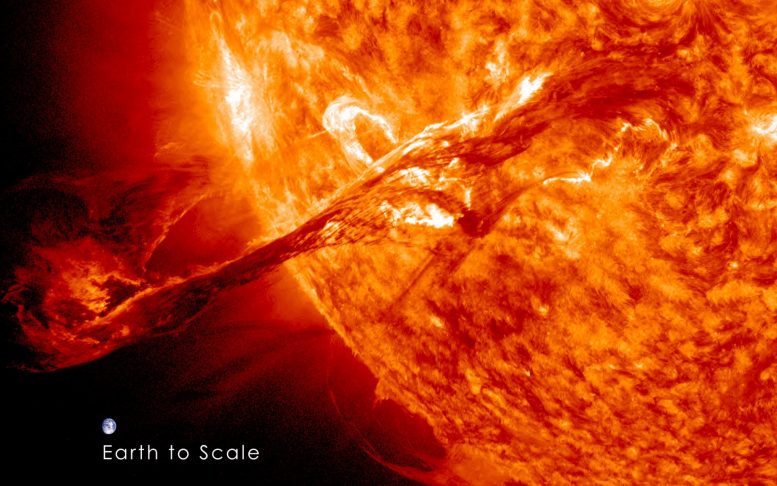
In a dramatic, multi-staged eruption, the Sun has revealed new clues that could help scientists solve the long-standing mystery of what causes the Sun’s powerful and unpredictable eruptions. Uncovering this fundamental physics could help scientists better predict the eruptions that cause dangerous space weather conditions at Earth.
This explosion contained components of three different types of solar eruptions that usually occur separately – making it the first time such an event has been reported. Having all three eruption types together in one event provides scientists with something of a solar Rosetta Stone, allowing them to translate what they know about each type of solar eruption to understand other types and uncover an underlying mechanism that could explain all types of solar eruptions.
“This event is a missing link, where we can see all of these aspects of different types of eruptions in one neat little package,” said Emily Mason, lead author on the new study and solar scientist at NASA’s Goddard Space Flight Center in Greenbelt, Maryland. “It drives home the point that these eruptions are caused by the same mechanism, just at different scales.”
Eruptions on the Sun usually come in one of three forms: a coronal mass ejection, a jet, or a partial eruption. Coronal mass ejections – CMEs – and jets are both explosive eruptions that cast energy and particles into space, but they look very different. While jets erupt as narrow columns of solar material, CMEs form huge bubbles that expand out, pushed and sculpted by the Sun’s magnetic fields. Partial eruptions, on the other hand, start erupting from the surface but don’t conjure enough energy to leave the Sun, so most of the material falls back down onto the solar surface.
In this eruption – observed with NASA’s Solar Dynamics Observatory and the European Space Agency and NASA’s Solar and Heliospheric Observatory on March 12 and 13, 2016 – the scientists saw the ejection of a hot layer of solar material above a magnetically active region on the Sun’s surface. The ejection was too big to be a jet, but too narrow to be a CME. Within a half an hour, a second cooler layer of material on the surface also started to erupt from the same place, but ultimately it fell back down as a partial eruption. Seeing an eruption with both jet and CME characteristics tells scientists they’re likely caused by a singular mechanism.
An unusual eruption on the Sun may offer clues to understanding our star’s mysterious explosions. The new research studied an event named the “Rosetta Stone” of solar eruptions. Just as the Rosetta Stone was the key to understanding Egyptian hieroglyphics, studying this eruption could be the key to understanding all types of solar eruptions. Credit: NASA/Mara Johnson-Groh/Haley Reed
With this new understanding, scientists can apply what they know about jets to CMEs. The event also tells scientists that partial eruptions occur on the same spectrum but encounter some yet-unknown limiter that restricts their energy and doesn’t allow them to make it off the Sun.
Understanding the mechanism behind these events, especially CMEs, is of critical importance to predicting when a large eruption might cause disruptions at Earth. CMEs in particular release large clouds of high-energy charged particles and magnetic fields that stream out across the solar system and can result in the space weather – a storm of high-energy particles and activity that can be dangerous to astronauts and technology in space and, in extreme cases, utility grids on Earth.
By modeling the new Rosetta eruption and others since discovered like it, the scientists hope they can figure out what root mechanism causes solar eruptions and determines their characteristics. Finding a trigger could ultimately allow scientists to predict when a large eruption could threaten Earth and Mars several hours in advance – providing enough time for astronauts and spacecraft operators to take precautionary measures.
The new study was presented on June 7, 2021, by Mason at the AAS 238 meeting and has been accepted for publication in Astrophysical Journal Letters.
3 Comments
Rosetta eruption from thè sun consist of following parts of
1unique phenomena-
1.CMEs,caused due to occasional change
in solar ìnternal magnetic field is a natural occuŕance as origino sun’s position in the galaxy.
2.Jet,eruption is dueto effect of sun’s grviþy of change in magnetism causing CMEs.
3.partial eruption is mere lateral effectof previous two eruptions is a virtual event of balancing fòces.
Rosetta eruption from thè sun consist of following parts of
1unique phenomena-
1.CMEs,is caused due to occasional change in solar internal magnetic field.
Sun during rotation around the centre of galaxy due to facts of nature or supermassive black hole rooted in self occures so.
2.Jet,eruption is dueto effect of sun’s grviþy of change in magnetism causing CMEs.
3.partial eruption is mere lateral effectof previous two eruptions is a virtual event of balancing fòces.
THE SUN LOOKS LIKE A RATHER UNPLEASANT PLACE.